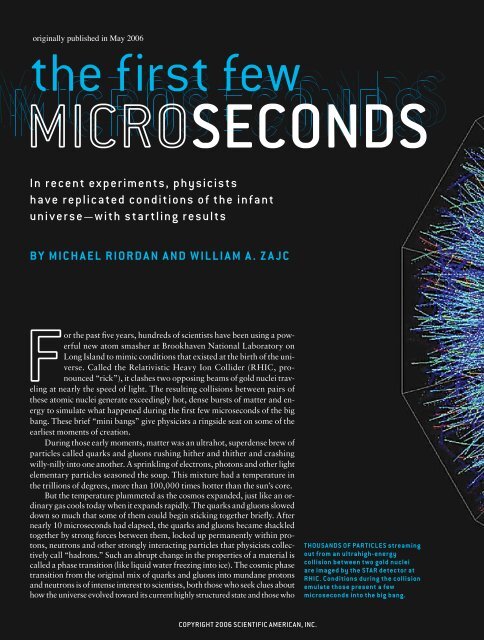Extreme Physics II - Physics and Astronomy
Extreme Physics II - Physics and Astronomy
Extreme Physics II - Physics and Astronomy
Create successful ePaper yourself
Turn your PDF publications into a flip-book with our unique Google optimized e-Paper software.
originally published in May 2006<br />
the first few<br />
MICROSECONDS<br />
SECONDS<br />
In recent experiments, physicists<br />
have replicated conditions of the infant<br />
universe— with startling results<br />
BY MICHAEL RIORDAN AND WILLIAM A. ZAJC<br />
For the past fi ve years, hundreds of scientists have been using a powerful<br />
new atom smasher at Brookhaven National Laboratory on<br />
Long Isl<strong>and</strong> to mimic conditions that existed at the birth of the universe.<br />
Called the Relativistic Heavy Ion Collider (RHIC, pronounced<br />
“rick”), it clashes two opposing beams of gold nuclei traveling<br />
at nearly the speed of light. The resulting collisions between pairs of<br />
these atomic nuclei generate exceedingly hot, dense bursts of matter <strong>and</strong> energy<br />
to simulate what happened during the fi rst few microseconds of the big<br />
bang. These brief “mini bangs” give physicists a ringside seat on some of the<br />
earliest moments of creation.<br />
During those early moments, matter was an ultrahot, superdense brew of<br />
particles called quarks <strong>and</strong> gluons rushing hither <strong>and</strong> thither <strong>and</strong> crashing<br />
willy-nilly into one another. A sprinkling of electrons, photons <strong>and</strong> other light<br />
elementary particles seasoned the soup. This mixture had a temperature in<br />
the trillions of degrees, more than 100,000 times hotter than the sun’s core.<br />
But the temperature plummeted as the cosmos exp<strong>and</strong>ed, just like an ordinary<br />
gas cools today when it exp<strong>and</strong>s rapidly. The quarks <strong>and</strong> gluons slowed<br />
down so much that some of them could begin sticking together briefl y. After<br />
nearly 10 microseconds had elapsed, the quarks <strong>and</strong> gluons became shackled<br />
together by strong forces between them, locked up permanently within protons,<br />
neutrons <strong>and</strong> other strongly interacting particles that physicists collectively<br />
call “hadrons.” Such an abrupt change in the properties of a material is<br />
called a phase transition (like liquid water freezing into ice). The cosmic phase<br />
transition from the original mix of quarks <strong>and</strong> gluons into mundane protons<br />
<strong>and</strong> neutrons is of intense interest to scientists, both those who seek clues about<br />
how the universe evolved toward its current highly structured state <strong>and</strong> those who<br />
COPYRIGHT 2006 SCIENTIFIC AMERICAN, INC.<br />
THOUSANDS OF PARTICLES streaming<br />
out from an ultrahigh-energy<br />
collision between two gold nuclei<br />
are imaged by the STAR detector at<br />
RHIC. Conditions during the collision<br />
emulate those present a few<br />
microseconds into the big bang.

















